Exploring Dubai's Architectural Marvels: Iconic Towers
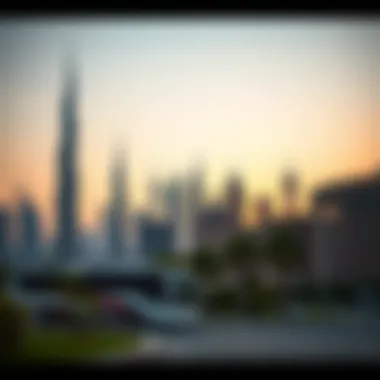
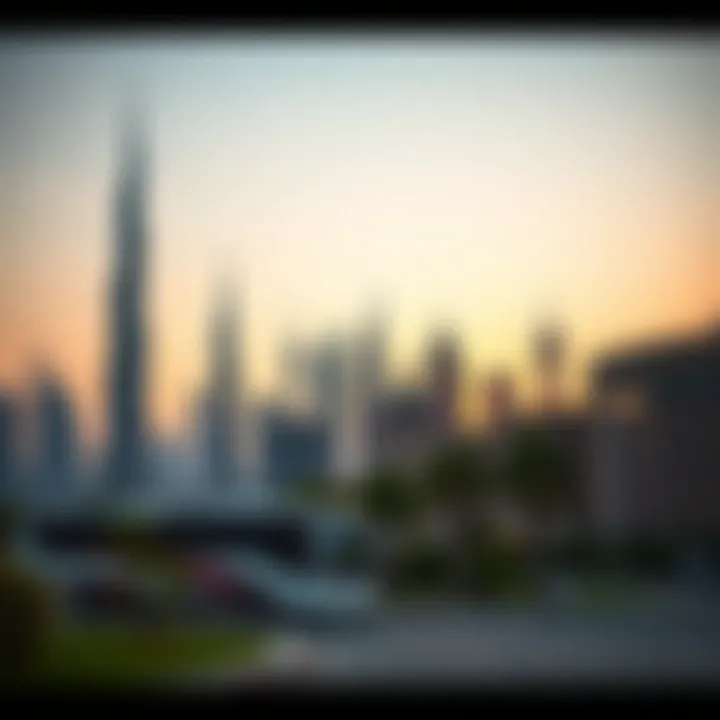
Intro
Dubai's skyline is a testament to the audacity of modern architecture, rising majestically in a desert landscape that has drawn eyes from all corners of the globe. The city's towers are more than mere buildings; they embody ambitions, innovation, and a gritty determination to carve an identity in a world that often craves the exotic and the extraordinary. Each tower tells a story, representing a dialogue between functionality and aesthetics, a balance between the dreamlike and the practical.
As we delve into this architectural journey, it is essential to understand the trends that have shaped Dubai's real estate sector. The market surrounding these towering giants is not static; it ebbs and flows with the pulse of local and international economies, societal shifts, and technological advancements. Investors, buyers, and industry agents alike must grasp not only the current landscape but also the trajectories that lie ahead.
In this exploration, we will cover various aspects of Dubai's iconic towers—from the eclectic designs that challenge the limits of engineering to the vibrant neighborhoods that prosper in their shadows. This narrative will unpack how these structures influence and enhance the cultural fabric of the city while also presenting lucrative opportunities for astute investors.
In the following sections, expect a rich tapestry of insights into the market trends, predictions, and smart investment strategies that can lead to fruitful ventures in this booming metropolis.
Foreword to Dubai's Skyline
Dubai's skyline stands not just as a collection of buildings, but as a story carved in steel and glass. This towering narrative showcases the ambition and creativity that characterize this ever-evolving city. The importance of understanding the skyline cannot be overstated; it serves as a symbol of the city's rapid development, a beacon of architectural innovation, and a marker of cultural identity. If one wishes to grasp the essence of modern Dubai, the towers are where they should start—their silhouettes are etched into the city's personality.
Historical Context
To appreciate the current skyline, one must look at the foundations of Dubai. Historically, this area was known for its trading routes and pearling industry. The city transformed in the 20th century, driven largely by oil discovery. The boom brought wealth and attracted a diverse population. Throughout the years, ambitious projects began to reshape the city's landscape, starting from simple low-rise buildings to what we see today.
For instance, the opening of the Burj Khalifa in 2010 marked a pivotal moment. It symbolized Dubai not only as a financial hub but as a global city that set its sights on establishing a legacy. Many structures echo elements from both traditional Arabian architectural styles and modern designs—an amalgamation that reflects the journey of a city that successfully bridged its deep-rooted past with its vibrant aspirations.
Cultural Significance of Towers
Towers in Dubai are not just functional spaces; they are cultural icons. Each tower has a narrative, often reflecting the ethos of the time it was built. They serve as venues for international business, luxurious living, and tourism, therefore contributing significantly to Dubai's economy. Take the Burj Al Arab, often dubbed the world’s only 7-star hotel, which stands as a testament to luxury and hospitality in the Emirates. Its design alone, inspired by the sail of a dhow, brings a cultural element to the forefront, sparking conversation about Arab heritage.
Additionally, these towers function as gathering points for residents and tourists alike, fostering a shared community experience. Each offers unique architectural features and breathtaking vistas, encouraging interaction and engagement.
Moreover, the skyline has cemented Dubai's place on the world stage, attracting millions of visitors yearly. It signifies a relentless pursuit of excellence and a place where cultures collide and coalesce, making it essential for investors and stakeholders to understand these nuances as they navigate the real estate landscape surrounding these architectural marvels.
Notable Towers in Dubai
The skyline of Dubai is peppered with towers that each tell a story of ambition and innovation. These notable towers do not just serve practical purposes; they embody the spirit of a city that has transformed from a modest fishing village into a global crossroads of trade, tourism, and culture. Their architectural grandeur and strategic locations have paved the way for economic opportunities, drawing investors, tourists, and residents alike. The journey through these towers serves as a navigation guide, not just through a physical landscape, but through the very essence of what Dubai represents today.
Burj Khalifa: A World Icon
Design and Architecture
The Burj Khalifa stands as a beacon of what is possible in modern architecture. Its design, resembling a desert flower, beautifully harmonizes with the city’s climate while achieving functional excellence. The unique height of 828 meters sets it apart globally, making it not just the tallest building but an unparalleled engineering feat. The structure's triple-lobed footprint creates a stable base that highlights its simplicity and elegance.
This striking architectural choice has its benefits, primarily by maximizing the available space without sacrificing aesthetics or stability. The Burj Khalifa’s tiered design also allows for spectacular observation decks and stylish residential spaces, showcasing how form and function can easily intertwine. However, such lofty goals come with challenges; the higher the structure, the more intricate the engineering must be to contend with wind pressures and temperature variations.
Impact on Tourism
When it comes to tourism, the Burj Khalifa is a heavyweight. Attracting millions of visitors annually, it's not just another attraction but rather a pilgrimage for those wanting to witness its observation deck views. The building has set the tone for experience-driven tourism, showcasing Dubai's commitment to delivering exceptional experiences.
Moreover, the Burj Khalifa's prominence helps to solidify Dubai’s brand as a luxury destination. Visitors often flock to the observation decks to enjoy views that encompass the stunning Palm Jumeirah and the endless Arabian Gulf. The alluring promise of high-altitude vistas sets the Burj Khalifa apart in a crowded list of tourist attractions, thus significantly boosting its economic impact. On the downside, such influx of tourists can lead to overcrowding, diverting resources from other less-known sites.
Comparison with Other Skyscrapers
In comparing the Burj Khalifa with other skyscrapers, it quickly becomes clear that it occupies a unique position. For instance, buildings like the Shanghai Tower and One World Trade Center rival its height but tend to follow conventional tower designs. The Burj Khalifa’s aesthetic appeal and cultural symbolism make it a standout.
While other skyscrapers emphasize functionality, the Burj Khalifa serves both an operational and symbolic role, showcasing Dubai’s aspirations. The dominance of this tower leads to an overshadowing effect, often making other high-rises appear less significant. Ultimately, the Burj Khalifa defines the narrative of upward growth, a quality seen in few other skylines worldwide.
The Burj Al Arab: Symbol of Luxury
Unique Design Elements
The Burj Al Arab’s sail-like silhouette stands as a true representation of luxury and opulence. Its unique design, appearing to rise from the water, instantly captivates. The hotel is not just a building; it's an experience, made even more exclusive with its two helipads and extravagant interiors, which prioritize guest comfort above all else.
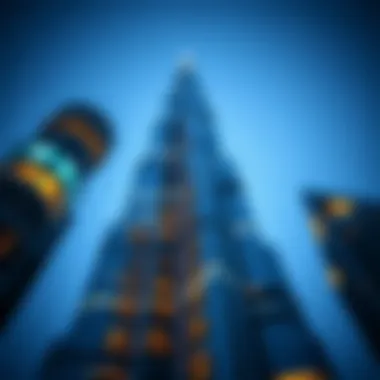
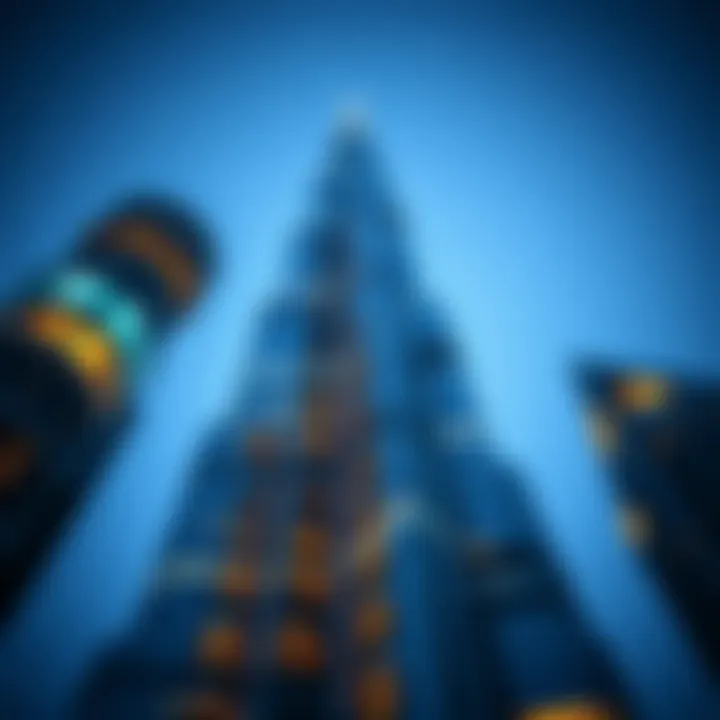
This architectural marvel is a visual feast, using high-quality materials like glass and gold leaf, contributing to its lavish aesthetic. Such attention to detail solidifies its reputation as one of the most luxurious hotels globally. However, the costs associated with maintaining such high standards can be seen as disadvantages amid criticisms of extravagance in a country striving for diversity in its economic foundations.
Hospitality Offerings
The Burj Al Arab’s hospitality offerings take luxury to another level. With a dedicated butler for every room and a range of world-class dining options, guests experience an unparalleled level of service. Also, its amenities include lavish spas and access to private beaches—a big draw for wealthy tourists.
These features create not only memorable stays but also stimulate local economies. Each experience is tailored, enhancing the hotel's desirability as a premier destination. The downside, however, is that such bespoke services often come with a hefty price, making it inaccessible to many, which can limit its market.
Cultural Heritage
Culturally, the Burj Al Arab reflects the UAE's ambitions and traditional values. It represents a blending of modern luxury with the region’s heritage, drawing from the maritime culture that has shaped Dubai. This cultural layering enriches its importance, giving visitors a touch of the local essence before they even step foot in the building.
Despite its modernity, it holds onto traditional Arabian hospitality, which is a significant factor for many tourists seeking authenticity. However, its contrasts with more traditional architectural forms may also be critiqued as diverging too much from authentic cultural expressions.
Emirates Towers: A Business Landmark
Architectural Influences
Emirates Towers embody a mixture of modern innovation and cultural motifs, making them emblematic of international business architecture in the Middle East. These towers, with their sleek glass and steel facades, showcase a refreshing modernism while incorporating elements of Islamic design, reflecting Dubai's heritage.
The architecture is not merely about aesthetics; it aligns with operational excellence in a competitive business environment, providing necessary space while elevating corporate branding. However, the influence of modern architecture sometimes lends itself to a homogenized skyline, potentially sacrificing local identity for global appeal.
Role in the Business District
The towers are not just structures—they play a pivotal role in Dubai’s business district. Hosting numerous multinational companies, they serve as a symbol of economic ambition while driving job creation and knowledge transfer in the region. This concentration of corporate activity spurs continuous investment, making it a crucial hub for business and innovation.
The dynamic environment it fosters benefits not only the tenants but also the surrounding communities, leading to increased foot traffic, restaurants, and retail spaces. The only challenge lies in maintaining that balance between business focus and livability, which can be threatened by urban sprawl and overcrowding.
Sustainability Features
In the context of sustainability, Emirates Towers are designed with energy efficiency in mind. They feature advanced cooling systems and intelligently designed shading, which add up to reduced energy consumption. This proactive approach not only eases the ecological footprint but also sets a standard for sustainable business practices.
Despite these features, criticism exists regarding the towers' reliance on mechanical systems, which can be expensive to operate and maintain. Nonetheless, their commitment to sustainability is commendable, reinforcing the conversation around responsible development in rapidly growing urban centers.
Marina 101: Rise of Residential Towers
Design and Features
Marina 101 is a compelling example of modern residential design, soaring high above the Dubai Marina with its sleek lines and innovative layout. Its aesthetic draws heavily from contemporary influences but is tailored to meet the needs of urban residents, providing not just apartments, but a lifestyle.
The structure’s unique features include an impressive blend of luxury amenities, such as an infinity pool and recreational areas, fostering a sense of community among residents. However, while the design appeals to high-end buyers, its maintenance costs can be daunting for some homeowners, particularly in this fast-paced market.
Market Trends
In today's market, residential towers like Marina 101 cater to an increasing demand for luxury properties. With the growing interest in Dubai’s real estate, newer trends show a shift towards lifestyle-focused communities that prioritize amenities and family-friendly designs.
The orchestra of high demand and limited supply contributes to soaring property values, making investments in such developments particularly appealing. That said, fluctuations in the market can leave some investors wary, especially in an economic landscape that can shift rapidly.
Residential Appeal
The appeal of Marina 101 extends beyond its architecture; its location along the waterfront adds immense value. Residents enjoy picturesque views and access to leisure activities, enhancing the residential experience. It serves as a microcosm of what modern living can embody, emphasizing convenience while being close to the pulse of city life.
However, the focus on luxury can alienate certain segments of the population, potentially sidelining those looking for more affordable living options, which could skew market viability in the long run.
Almas Tower: The Diamond Tower
Security Innovations
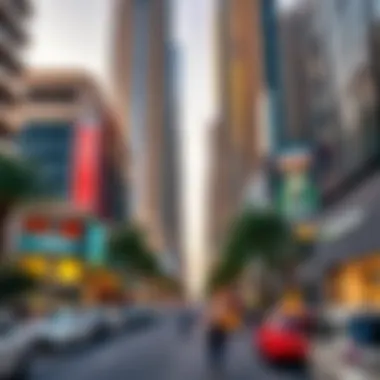
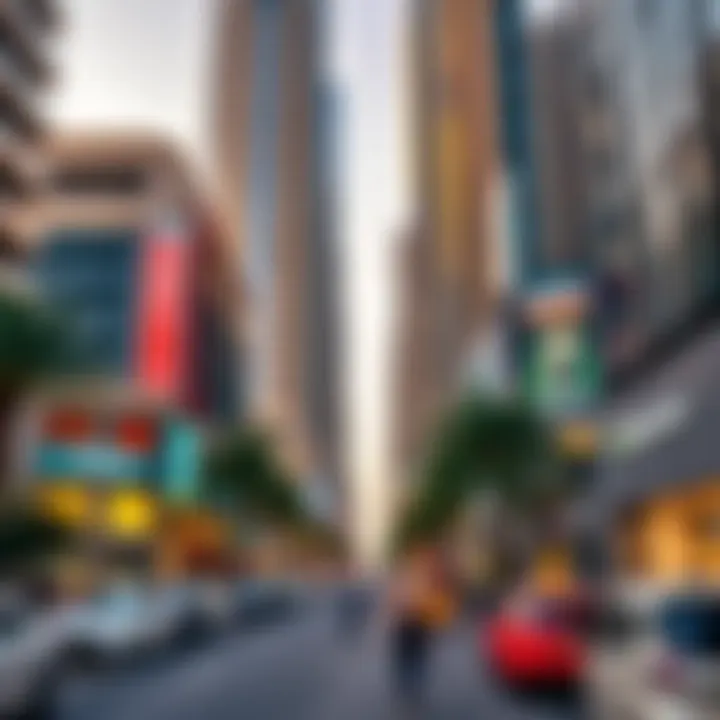
Almas Tower, known as the Diamond Tower, integrates security innovations that stand as a model for commercial buildings around the globe. Not only does it provide a highly secure environment for its tenants, but it also utilizes advanced surveillance and safety technologies to create a secure workplace.
This unique focus on security elevates its status in Dubai’s business landscape, appealing to companies that prioritize the safety of their operations. Yet, the sophisticated security can bring about complaints regarding accessibility and may deter some smaller businesses that simply cannot comply with stringent safety protocols.
Commercial Space Dynamics
The tower’s architectural design features are complemented by a strategic allocation of commercial spaces, which enhances its functionality. Companies in diverse industries thrive here, benefiting from collaboration and networking opportunities.
This dynamic creates a bustling environment and contributes to the tower’s allure. Nevertheless, the competition for space can drive up rental prices, posing a challenge for new businesses attempting to establish themselves.
Cultural Reflections
Almas Tower stands as more than just a commercial building; it reflects the aspirations of the UAE to be a leader in the global market. Its design evokes the beauty of diamonds, indicating luxury and success that are inextricably linked with the cultural identity of the region.
This symbolism enriches the tower’s significance, but one must also consider whether such symbols might overshadow the cultural narratives of less grandiose establishments, leading to a rhetoric of exclusivity rather than inclusivity.
Architectural Styles of Towers
The architectural styles of towers in Dubai are not just a reflection of current trends; they embody the spirit of innovation and cultural expression that defines this city. In a region where the horizon is punctuated by remarkable structures, understanding these styles offers insights into how they shape urban identity and influence both the skyline and the economy. These styles range from modern masterpieces to structures that pay homage to traditional designs, each contributing to Dubai’s diverse architectural narrative.
Modernist Designs
Modernism in architecture is characterized by its minimalistic approach, clean lines, and the use of contemporary materials. In Dubai, this design philosophy has flourished, giving rise to towers that not only reach for the skies but also redefine the concept of spatial efficiency and functionality. For example, the Burj Khalifa, standing at a staggering height of 828 meters, exemplifies modernist principles. Its streamlined design minimizes wind resistance and maximizes structural integrity. Additionally, the use of glass and steel not only enhances aesthetic appeal but also plays a critical role in energy efficiency.
This approach has attracted top-tier architects and engineers, leading to innovative designs such as the twisting structure of the Cactus Tower, which challenges conventional architectural norms while promoting sustainability. These modernist towers serve dual purposes: they enhance the city's global image while providing essential spaces for work and living.
Traditional Elements Influencing Modern Towers
Even as Dubai rockets into the future with stunning modern designs, the influence of traditional Islamic architecture remains deeply rooted in many tower constructions. Elements such as intricate geometric patterns, arches, and minarets can often be seen integrated into contemporary designs, creating a dialogue between the past and present. The Al-Fahidi Historical Neighborhood is an excellent case where the interplay between traditional structures and modern towers can be examined.
The incorporation of these cultural motifs not only respects the heritage but also gives tourists and residents alike a sense of belonging and identity. It captures the essence of Dubai’s ambitions—growth and modernity, complemented by historical acknowledgment.
Sustainable Architecture Trends
As the world pivots towards sustainability, Dubai is embracing this need within its architectural framework. Modern towers now frequently include eco-friendly features such as solar panels, green roofs, and rainwater harvesting systems. Structures like the Dubai Design District's innovative buildings are modeled to reduce carbon footprints while optimizing energy usage.
This sustainable architectural trend plays a significant role in attracting investors and residents who prioritize environmental consciousness. Moreover, local authorities are increasingly mandating that new tower designs meet strict sustainability criteria—an effort to ensure that Dubai not only dazzles with its skyline but also stands as a model of ecological responsibility.
"Sustainability in Dubai isn't just a trend; it's a necessity for future survival amidst urban growth."
By incorporating these compelling architectural styles, Dubai is not just constructing skyscrapers but creating a cohesive urban ecosystem that represents progress, culture, and sustainability—key pillars that will serve as guiding principles in its continuous evolution.
The Impact of Towers on Dubai's Economy
Towers in Dubai are not just striking elements of the skyline; they play a pivotal role in shaping the economic landscape of the city. These soaring structures have become symbols of prosperity and ambition, welcoming both tourists and investors alike. Several key elements highlight their importance, ranging from market dynamics to job creation, each contributing to Dubai's rapid growth and economic diversification.
Real Estate Market Dynamics
The presence of iconic towers profoundly influences the real estate market in Dubai. With each tower representing significant investments, they serve as benchmarks for property values. The booming demand for commercial and residential spaces directly correlates with the continued success of these structures. Investors find themselves drawn to locations where sky-high cranes dominate the landscape, signaling ongoing developments.
- Prime Locations: Towers are often situated in prime areas, creating a spatial synergy that enhances property appeal.
- Luxury vs. Affordability: The diversity in tower designs accommodates various market segments, catering to both luxury buyers and mid-range investors.
- Global Influence: Dubai’s towers have garnered international attention, leading to increased inquiries from foreign investors keen on tapping into this vibrant market.
In essence, the dynamics of Dubai’s real estate are intricately linked with the towers erected within its expanse, making them a central focus for investors and developers.
Investment Opportunities Surrounding Towers
Investment opportunities surrounding Dubai’s towers are plentiful and varied. As these structures attract tourism, businesses flock to establish themselves nearby, resulting in a prosperity cycle. Investors often examine the following aspects when considering their opportunities:
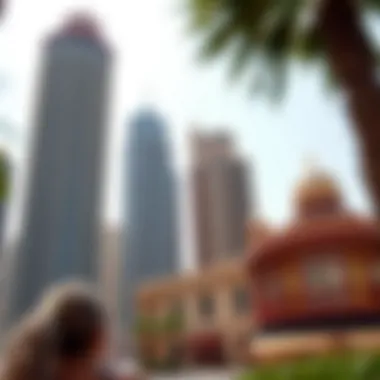
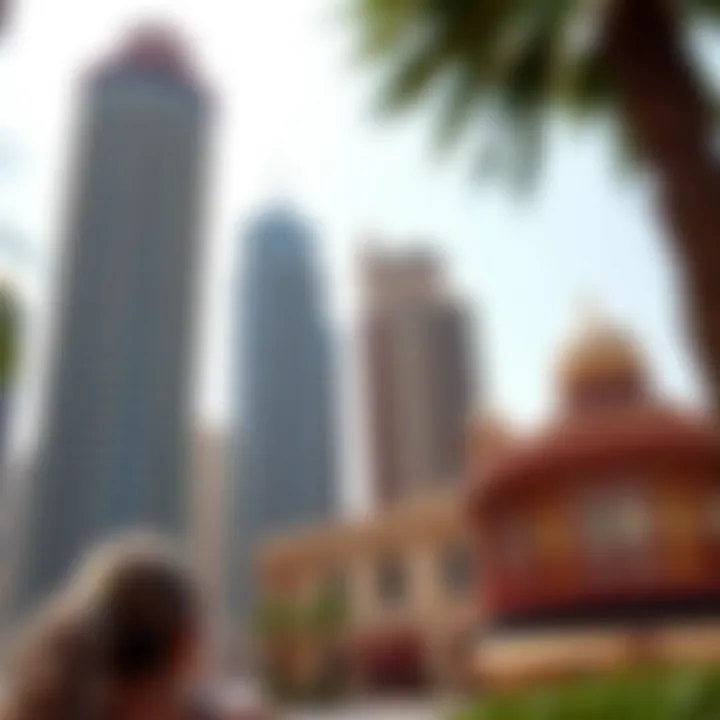
- Commercial Space Demand: The high foot traffic generated by popular towers leads to soaring demand for nearby retail and office spaces.
- Tourism-Driven Investments: Spectacular views and unique experiences draw tourists, which in turn boosts food, entertainment, and retail sectors around these towers.
- Government Support: Dubai's government policies often favor foreign investment, creating a welcoming atmosphere for potential investors in tower-related projects.
The investment climate surrounding these true architectural marvels continues to thrive, reflecting Dubai’s future as an economic powerhouse.
Job Creation and Economic Growth
The towers of Dubai have an undeniable impact on job creation and overall economic growth. Each towering installation creates not only temporary construction jobs but also long-term employment opportunities in the following fields:
- Construction and Maintenance: Jobs are generated during the construction phase, leading to further employment in maintenance and management roles once the towers are completed.
- Service Sector Expansion: Hotels, restaurants, and retail establishments that develop around these towers require additional staffing, resulting in a significant increase in service-oriented jobs.
- Innovation and Technology Roles: As towers adopt sustainable practices and new technologies, demand for skilled labor in these areas surges, promoting an educated workforce.
"Skyscraper projects do not just redefine the skyline; they redefine the economic fabric of the city."
In summary, the job creation linked to these towers fosters a ripple effect of economic growth, enriching the lives of many and providing diverse opportunities for those entering the labor market in Dubai.
Overall, the impact of towers on Dubai's economy goes beyond mere aesthetics. They serve as the backbone for real estate activities, investment opportunities, and employment growth, making them vital to the city’s success story. By continuing to explore and leverage these towering assets, Dubai fortifies its position as a global economic hub.
The Future of Tower Developments
As cities around the globe evolve, so too does the architecture that defines their skylines. Dubai, known for its awe-inspiring towers, is no exception. The future of tower developments in this dynamic city is not just about increasing height; it’s also about functionality, sustainability, and the ability to adapt to changing lifestyles. The significance of this topic lies in understanding how these towering structures can contribute positively to urban living, climate resilience, and economic viability.
Emerging Trends in Tower Construction
One cannot overlook the fact that the skyscraper game is constantly changing, with new trends shaping the way towers are constructed in Dubai.
- Mixed-Use Developments: There is a noticeable shift towards mixed-use towers that combine residential, commercial, and leisure spaces, creating self-sustaining communities. A prime example is the upcoming Dubai Creek Harbour, where the design intends to facilitate a vibrant ecosystem.
- Vertical Gardens: Increasingly, designs feature green spaces in the sky. Vertical gardens not only beautify a building but also enhance air quality and provide a pleasant environment for tenants. Places like the Marina 101 are at the forefront of this trend that adds a breath of fresh air amidst the concrete jungle.
- Modular Construction: This method allows parts of the buildings to be constructed off-site and assembled on location. It drastically reduces construction time and labor costs while maintaining quality. As the real estate market in Dubai intensifies, quicker turnarounds can provide a competitive advantage.
Technological Innovations in Design
Technology is reshaping every facet of our lives, and it's no different in the realm of architecture. The towers of tomorrow are outfitted with innovative technologies that will redefine not just how they look but how they function.
- Smart Building Technologies: Sensors and automation systems are becoming commonplace in new constructions. These systems can control lighting, heating, and cooling automatically based on occupancy and preferences, optimizing energy consumption.
- 3D Printing: This technology is paving the way for more complex designs that were once thought impossible to achieve within traditional construction frameworks. Dubai is actively embracing 3D printed structures, believing it could revolutionize future skyscraper designs.
- Sustainable Materials: With a growing emphasis on sustainability, using recycled and eco-friendly materials in construction can significantly reduce the carbon footprint of new towers. This is not just a trend; it is becoming a necessary consideration in all aspects of design and construction.
Urban Planning and New Towers
Urban planning plays a critical role in managing how these new towers fit into the existing fabric of Dubai. As the skyline changes, so must the infrastructure and the services around these developments.
- Transportation Links: Future towers need to be integrated into the city’s public transportation networks seamlessly. New development projects are prioritizing proximity to metro stations and bus lines to reduce reliance on cars.
- Community Spaces: Incorporating public spaces such as parks, plazas, and recreational areas is essential for creating livable urban environments. These spaces provide relief from the hustle of city life and foster community interaction.
- Zoning Regulations: Dubai's urban landscape is guided by regulations that dictate where and how new towers can be built. Future developments will likely need to adhere to stricter guidelines that encourage ecological compatibility and aesthetic cohesion.
"The towers of tomorrow are not just feats of engineering; they are living testimonies to a city's aspirations and the community's needs."
In summary, the future of tower developments in Dubai is marked by innovation, sustainability, and a solid commitment to improving urban life. As architectural trends shift and societal expectations evolve, these towers will likely become more than just buildings—they will represent the synergy of cultural values, technological advancement, and environmental responsibility.
Closure: Towers as Symbols of Ambition
Dubai’s skyline, dominated by awe-inspiring towers, speaks volumes about the city’s relentless pursuit of progress and excellence. As we traverse through the iconic structures that punctuate this urban landscape, it becomes clear that these towers are not mere feats of engineering; they embody a narrative of ambition, innovation, and cultural identity.
When we look back on the collective journey of architectural expression here, each tower tells its own story intertwined with Dubai’s evolution. It reflects not just the aspirations of their creators, but the dreams of a city that has risen from the desert sands to become a global hub for tourism, business, and culture. Burj Khalifa, for instance, stands tall as a beacon of human ingenuity, representing what can be achieved when vision meets execution. Its towering presence inspires not just those who live in its shadow but countless investors and entrepreneurs drawn to Dubai’s thriving economic landscape.
With the ever-changing market dynamics, there’s a tangible buzz surrounding real estate achievements and development opportunities. Towers like the Burj Al Arab symbolize luxury and sophistication, shaping perceptions of what it means to live and work in Dubai. They attract both high-net-worth individuals and ambitious companies seeking to make their mark in a competitive environment. This impact highlights the ongoing necessity for innovation and sustainability within the architectural sector.
“In Dubai, each tower is a chapter in the story of a remarkable transformation.”
The intertwining of local culture and modern design principles within these towers further enhances their significance. An architectural journey in Dubai is a fusion of traditional elements and futuristic dreams, creating spaces that not only serve functional needs but also express identity and pride.
Reflection on Dubai's Architectural Identity
Dubai’s architectural identity can be seen as both a reflection of its history and a projection of its future aspirations. As structures rise higher, they symbolize a collective resolve to reach beyond what seems possible. The architectural styles, from traditional to modern, demonstrate a versatile adaptability to global influences while retaining a unique cultural essence.
- Cultural Identity: Architectural elements in Dubai often draw inspiration from local heritage, blending regional styles with contemporary adaptations. Designs echo motifs found in traditional Islamic architecture, while also embracing modern aesthetics.
- Innovation: The desire to push boundaries has led to innovative designs and construction technologies. Towers often integrate smart systems aimed at sustainability and efficiency, mirroring global trends in environmentally-conscious building practices.
- Community Impact: Beyond their physical presence, these towers foster community interaction. The mixing of residential, commercial, and leisure spaces promotes a vibrant urban lifestyle, encouraging both locals and expatriates to build roots in the city.
This intricate relationship between ambition, culture, and architectural achievement sets Dubai apart as an example of modern urban development. The towers are not just structures; they are emblematic of a shared vision, painted against the backdrop of a city that continues to innovate and inspire on a grand scale.
For anyone eyeing investment opportunities in Dubai, the emphasis on architectural marvels underscores the potential for growth. As new towers are planned and constructed, the promise of enhanced quality of life alongside lucrative returns beckons, making now an opportune time to explore this dynamic market.
Through understanding the significance of these towers, one can truly appreciate how they stand as enduring symbols of ambition, echoing the dreams that built them and the aspirations that continue to drive Dubai forward.







